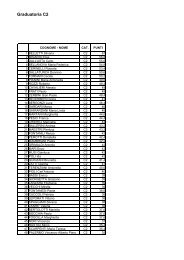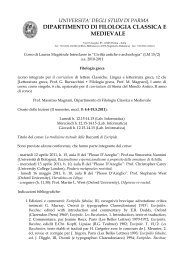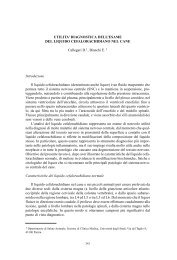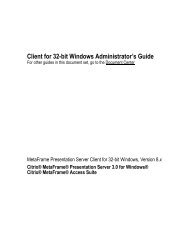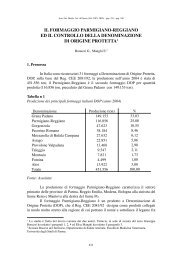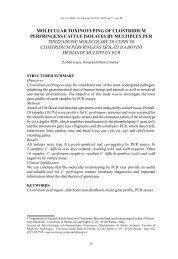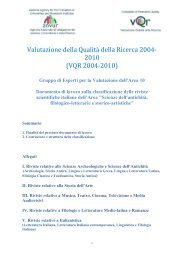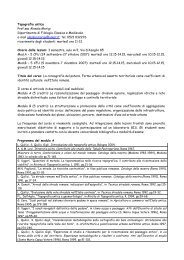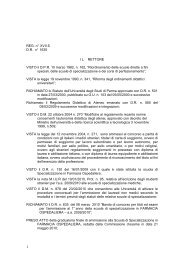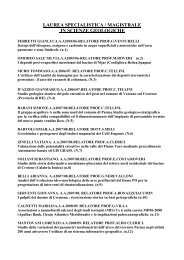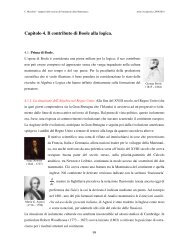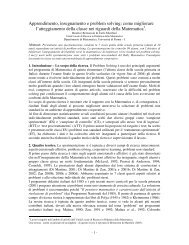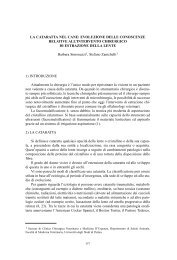Ann. Fac. Medic. Vet. di Parma (Vol. XXVII, 2007) pag. 143 - pag. 156Antibiotic adm<strong>in</strong>istration, especially <strong>in</strong> hospital environments, is the mostcommonly reported as predispos<strong>in</strong>g factor for the development <strong>of</strong> CDAD <strong>in</strong> people<strong>and</strong> horses, although there have been reports <strong>of</strong> CDAD <strong>in</strong> the absence <strong>of</strong> antibioticadm<strong>in</strong>istration. In contrast, adm<strong>in</strong>istration <strong>of</strong> antibiotics does not seem to predispose<strong>dogs</strong> to CDAD [7].Toxigenic C. difficile can be isolated from up to 94% <strong>of</strong> neonate <strong>dogs</strong> <strong>in</strong> theabsence <strong>of</strong> cl<strong>in</strong>ical signs <strong>of</strong> disease. Cl<strong>in</strong>ical signs that have been associated withcan<strong>in</strong>e C. difficile <strong>in</strong>fection range from asymptomatic carriage to a potentially fatalacute hemorrhagic diarrhoeal syndrome. As with C. perfr<strong>in</strong>gens, there does not seemto be a specific anatomic localization <strong>of</strong> cl<strong>in</strong>ical signs, <strong>and</strong> recent studies have shownthat <strong>dogs</strong> with suspected C. difficile-associated diarrhoea commonly have signs<strong>of</strong> small <strong>and</strong> large <strong>in</strong>test<strong>in</strong>al diarrhoea as well as diffuse disease characterized byconcurrent <strong>in</strong>volvement <strong>of</strong> both the small <strong>and</strong> large <strong>in</strong>test<strong>in</strong>e [7].As with C. perfr<strong>in</strong>gens, isolation <strong>of</strong> C. difficile from <strong>diarrhoeic</strong> specimensis <strong>of</strong> little diagnostic value, except for procur<strong>in</strong>g stra<strong>in</strong>s for detection <strong>of</strong> tox<strong>in</strong> genes<strong>and</strong> typ<strong>in</strong>g. Limitations <strong>in</strong> the isolation <strong>of</strong> C. difficile <strong>in</strong> <strong>dogs</strong> are underscored by thef<strong>in</strong>d<strong>in</strong>gs <strong>of</strong> several studies demonstrat<strong>in</strong>g no significant difference <strong>in</strong> isolation rates(0-40%) between non-<strong>diarrhoeic</strong> <strong>and</strong> <strong>diarrhoeic</strong> <strong>dogs</strong>, as above mentioned.Diagnosis <strong>of</strong> C. difficile-associated diarrhoea traditionally has been basedon positive fecal assays for tox<strong>in</strong> A or tox<strong>in</strong> B. The current gold st<strong>and</strong>ard assay isthe cell culture cytotoxicity assay, which detects tox<strong>in</strong> B activity; however, thisassay is expensive <strong>and</strong> requires up to 48 hours for conformation <strong>of</strong> a negative result.There are currently several commercially available immunoassays for detection <strong>of</strong>C. difficile tox<strong>in</strong> A or for detection <strong>of</strong> both tox<strong>in</strong>s A <strong>and</strong> B <strong>in</strong> fecal samples (for example,Premier Tox<strong>in</strong>s A & B, Meridian Bioscience, Inc, C<strong>in</strong>c<strong>in</strong>nati, OH; C. difficile TOXA/B II, TechLab, Inc., Blacksburg, VA; ProSpecT <strong>Clostridium</strong> difficile Tox<strong>in</strong> A/B,Remel, USA). Because <strong>of</strong> <strong>in</strong>creas<strong>in</strong>g reports <strong>of</strong> tox<strong>in</strong> A-negative <strong>and</strong> tox<strong>in</strong> B-positivestra<strong>in</strong>s isolated from cl<strong>in</strong>ical cases, the use <strong>of</strong> ELISA kits that detect both tox<strong>in</strong>s isga<strong>in</strong><strong>in</strong>g preference. None <strong>of</strong> the commercial ELISA kits currently available havebeen validated <strong>in</strong> the dog, however, <strong>and</strong> there is no st<strong>and</strong>ard assay used by veter<strong>in</strong>arydiagnostic laboratories. This fact is concern<strong>in</strong>g, given the wide range <strong>of</strong> specificities(66-100%) <strong>and</strong> sensitivities (33-95%) that have been reported for many <strong>of</strong> the kitswhen analyzed for human fecal tox<strong>in</strong> detection.Detection <strong>of</strong> toxigenic C. difficile stra<strong>in</strong>s after culture has been shown to be <strong>of</strong>little diagnostic value <strong>in</strong> the dog. First, there is no significant difference <strong>in</strong> detection <strong>of</strong>toxigenic stra<strong>in</strong>s between <strong>diarrhoeic</strong> <strong>and</strong> non-<strong>diarrhoeic</strong> <strong>dogs</strong>, <strong>and</strong>, second, isolation<strong>of</strong> the microrganism is difficult, costly, <strong>and</strong> time-consum<strong>in</strong>g. Nevertheless, studies <strong>in</strong>human be<strong>in</strong>gs have begun bypass<strong>in</strong>g culture <strong>of</strong> the microrganism <strong>and</strong> look<strong>in</strong>g for thepresence <strong>of</strong> specific tox<strong>in</strong> genes <strong>in</strong> DNA obta<strong>in</strong>ed from fecal specimens. Sensitivities<strong>of</strong> PCR detection methods have been reported to be between 96% <strong>and</strong> 100% whencompared with the cytotoxicity assay [7].The aim <strong>of</strong> this study was to def<strong>in</strong>e the prevalence <strong>of</strong> <strong>Clostridium</strong> spp. <strong>in</strong>95 fecal samples (36 <strong>diarrhoeic</strong> <strong>and</strong> 59 non-<strong>diarrhoeic</strong>) collected from <strong>dogs</strong> at theVeter<strong>in</strong>ary Faculty <strong>of</strong> Parma. Especially, we payed attention to C. perfr<strong>in</strong>gens <strong>and</strong>C. difficile isolation.148
Ann. Fac. Medic. Vet. di Parma (Vol. XXVII, 2007) pag. 143 - pag. 156Materials <strong>and</strong> methodsFecal samples were collected from 95 <strong>diarrhoeic</strong> <strong>and</strong> non-<strong>diarrhoeic</strong> <strong>dogs</strong>,41 female <strong>and</strong> 54 male, over an 8-mo period (20 th July 2006 - 20 th March 2007). Age<strong>of</strong> the <strong>diarrhoeic</strong> <strong>dogs</strong> (n= 36) ranged between 6 months <strong>and</strong> 12 years (mean, 4.2 yr;median, 3 yr), <strong>and</strong> that <strong>of</strong> the non-<strong>diarrhoeic</strong> <strong>dogs</strong> (n= 59) ranged between 3 months<strong>and</strong> 12 years (mean, 3.8 yr; median, 3 yr).Some <strong>dogs</strong> (n= 38) were kennelled <strong>dogs</strong>; others belonged to veter<strong>in</strong>arystudents <strong>and</strong> staff <strong>of</strong> the Veter<strong>in</strong>ary Faculty <strong>of</strong> Parma (n= 47). Ten <strong>dogs</strong> were admittedto the Didactic Veter<strong>in</strong>ary Hospital.All fecal specimens were naturally voided. Assays were performed on fecescollected with<strong>in</strong> 3 hours. After analysis, samples were immediately stored at -20°C.All fecal samples were cultured onto prereduced blood agar plates,conta<strong>in</strong><strong>in</strong>g vitam<strong>in</strong>e K, sheep blood <strong>and</strong> haem<strong>in</strong> (Schaedler agar, Oxoid, Bas<strong>in</strong>gstoke,Hampshire, Engl<strong>and</strong>), <strong>and</strong> at the same time <strong>in</strong>oculated <strong>in</strong> Cooked Meat Broth (Oxoid,Engl<strong>and</strong>). Samples were also streaked onto prereduced selective medium conta<strong>in</strong><strong>in</strong>gcycloser<strong>in</strong>e-cefoxit<strong>in</strong>-fructose agar (CCFA) for the isolation <strong>of</strong> C. difficile. Plateswere <strong>in</strong>cubated anaerobically at 37°C for 48-72 hours. After 72 hours <strong>of</strong> anaerobic<strong>in</strong>cubation <strong>in</strong> Cooked Meat Broth, the samples were subjected to heat shock forspore selection <strong>and</strong> then cultured onto Schaedler agar <strong>and</strong>/or CCFA to enhance sporegerm<strong>in</strong>ation <strong>and</strong> <strong>in</strong>crease culture yield.For C. perfr<strong>in</strong>gens identification, colonies show<strong>in</strong>g characteristic dualhaemolytic zones (Figure 1) were picked up <strong>and</strong> identified by Gram’s sta<strong>in</strong> <strong>and</strong>biochemical tests utiliz<strong>in</strong>g Rapid ID 32A (bioMérieux SA, Marcy-l’Etoile, France).Prelim<strong>in</strong>ary identification <strong>of</strong> C. difficile was based on colonial appearance (Figure2), odor (horse manure), lack <strong>of</strong> aerotolerance, cell morphology after Gram sta<strong>in</strong><strong>in</strong>g<strong>and</strong> typical chartreuse fluorescence under ultraviolet light. F<strong>in</strong>al identification wasperformed by us<strong>in</strong>g a rapid latex slide agglut<strong>in</strong>ation test (C. difficile, Oxoid, Engl<strong>and</strong>)<strong>and</strong> Rapid ID 32A biochemical pr<strong>of</strong>iles (bioMérieux SA, France). The other clostridiawere identified only biochemically (Rapid ID 32A, bioMérieux).All isolates were stored on cryopreservation beads (MAST Diagnostics,D.I.D, Diagnostic International Distribution S.p.A., Italy) at -70°C.Figure 1: Typical colonies <strong>of</strong> <strong>Clostridium</strong> perfr<strong>in</strong>gens onto Schaedler agar show<strong>in</strong>gcharacteristic dual haemolytic zones149



